
Map of Virginia
 |
The development organization for the SCRC program in Virginia functions within the Governor’s Office. Administration responsibilities for the development programs of the SCRC are assigned by the Governor to the Deputy Secretary of Commerce and Trade. As such, the Director serves as an Alternate State Member of the Commission.
SCRC will invest in the region’s economic future through a grant program, publishing research, and learning experiences to help communities grasp opportunities, address economic disparity, and prosper.
SCRC grants will require a varying degree of match from 20 percent to 50 percent depending on the level of distress in the county and will support basic infrastructure, business development, natural resources, and workforce/labor development.
The Local Development Districts (LDDs) are our local partners and are an active and essential part of the SCRC partnership. There are nine LDDs in Virginia’s SCRC region, and each LDD operates under a Board of Directors composed of elected representatives from the various local governments.
Virginia’s SCRC counties include Accomack, Albemarle, Alexandria city, Amelia, Amherst, Appomattox, Arlington, Augusta, Bedford, Brunswick, Buckingham, Campbell, Caroline, Charles City, Charlotte, Charlottesville city, Chesapeake city, Chesterfield, Clarke, Colonial Heights city, Culpeper, Cumberland, Danville city, Dinwiddie, Emporia city, Essex, Fairfax, Fairfax City, Falls Church city, Fauquier, Fluvanna, Franklin, Franklin city, Frederick, Fredericksburg city, Gloucester, Goochland, Greene, Greensville, Halifax, Hampton city, Hanover, Harrisonburg city, Henrico, Hopewell city, Isle Of Wight, James City, King And Queen, King George, King William, Lancaster, Loudoun, Louisa, Lunenburg, Lynchburg city, Madison, Manassas city, Manassas Park city, Mathews, Mecklenburg, Middlesex, Nelson, New Kent, Newport News city, Norfolk city, Northampton, Northumberland, Nottoway, Orange, Page, Petersburg city, Pittsylvania, Poquoson city, Portsmouth city, Powhatan, Prince Edward, Prince George, Prince William, Rappahannock, Richmond, Richmond city, Roanoke, Roanoke city, Rockingham, Salem city, Shenandoah, Southampton, Spotsylvania, Stafford, Staunton city, Suffolk city, Surry, Sussex, Virginia Beach city, Warren, Waynesboro city, Westmoreland, Williamsburg city, Winchester city, and York.
State Partners
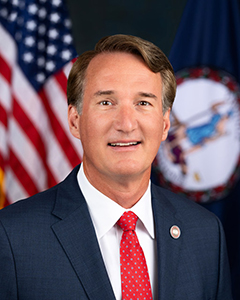
Governor Glenn Youngkin
Virginia Governor
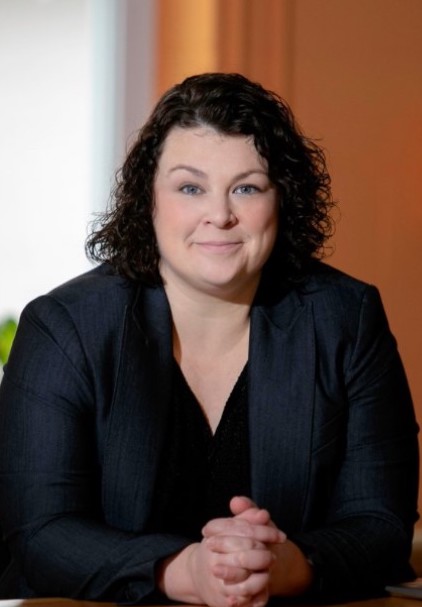
Maggie Beal
State Alternate / Deputy Secretary of Commerce and Trade

Matt Weaver
Director SCRC Programs / Associate Director Viginia Department Housing and Community

Rachel Jordan
SCRC State Program Manager
Investment Priorities

Map of South Carolina
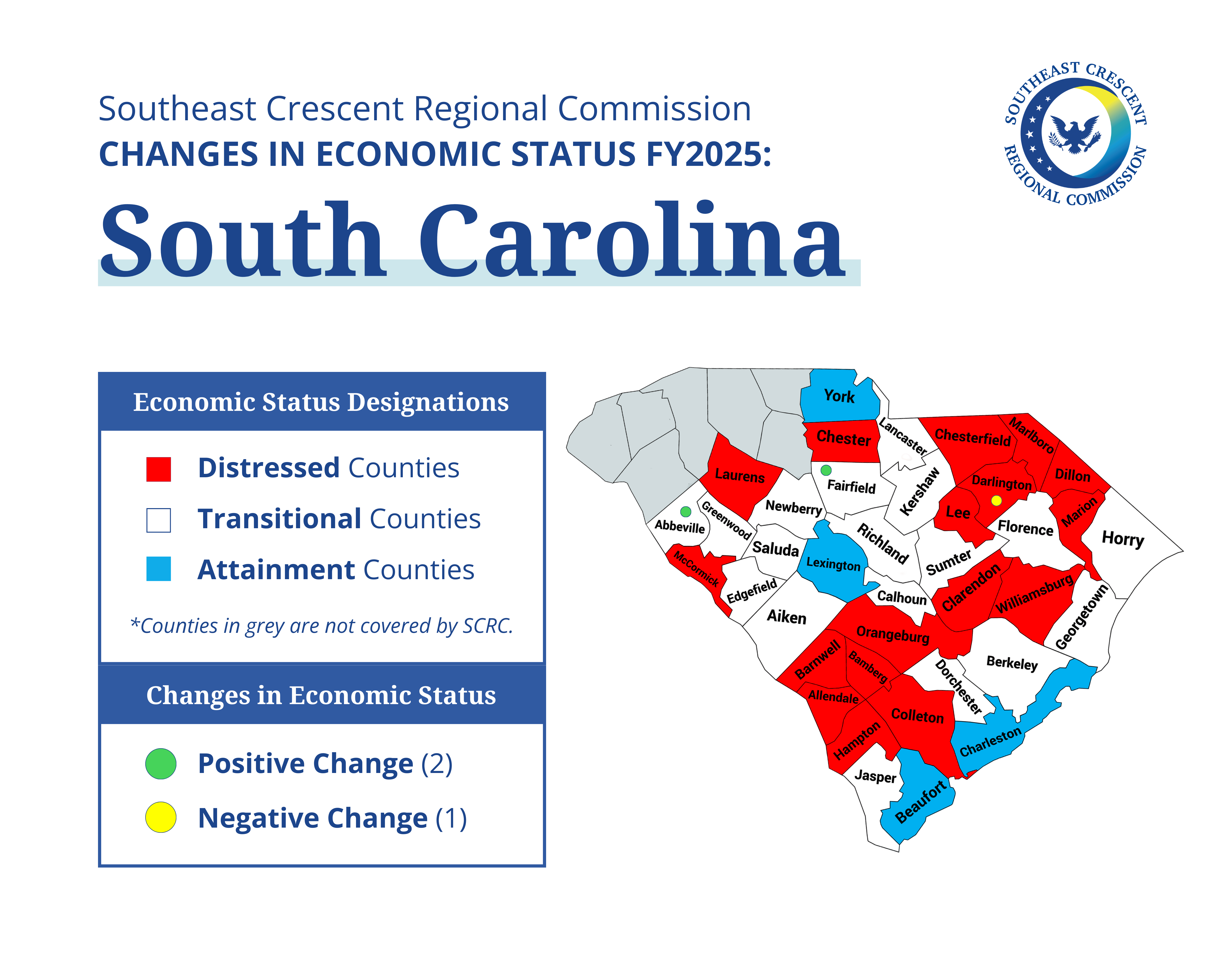 |
The development organization for the SCRC program in South Carolina functions within the Governor’s Office. Administration responsibilities for the development programs of the SCRC are assigned by the Governor to the Director, South Carolina Federal Affairs. As such, the Director serves as an Alternate State Member of the Commission.
SCRC will invest in the region’s economic future through a grant program, publishing research, and learning experiences to help communities grasp opportunities, address economic disparity, and prosper.
SCRC grants will require a varying degree of match from 20 percent to 50 percent depending on the level of distress in the county and will support basic infrastructure, business development, natural resources, and workforce/labor development.
The Local Development Districts (LDDs) are our local partners and are an active and essential part of the SCRC partnership. There are nine LDDs in South Carolina’s SCRC region, and each LDD operates under a Board of Directors composed of elected representatives from the various local governments.
South Carolina’s SCRC counties include Abbeville, Aiken, Allendale, Bamberg, Barnwell, Beaufort, Berkeley, Calhoun, Charleston, Chester, Chesterfield, Clarendon, Colleton, Darlington, Dillon, Dorchester, Edgefield, Fairfield, Florence, Georgetown, Greenwood, Hampton, Horry, Jasper, Kershaw, Lancaster, Laurens, Lee, Lexington, Marion, Marlboro, McCormick, Newberry, Orangeburg, Richland, Saluda, Sumter, Williamsburg, and York.
State Partners
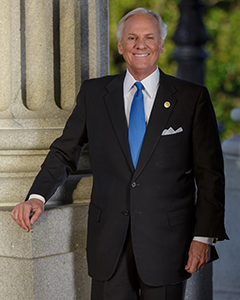
Governor Henry McMaster
South Carolina Governor
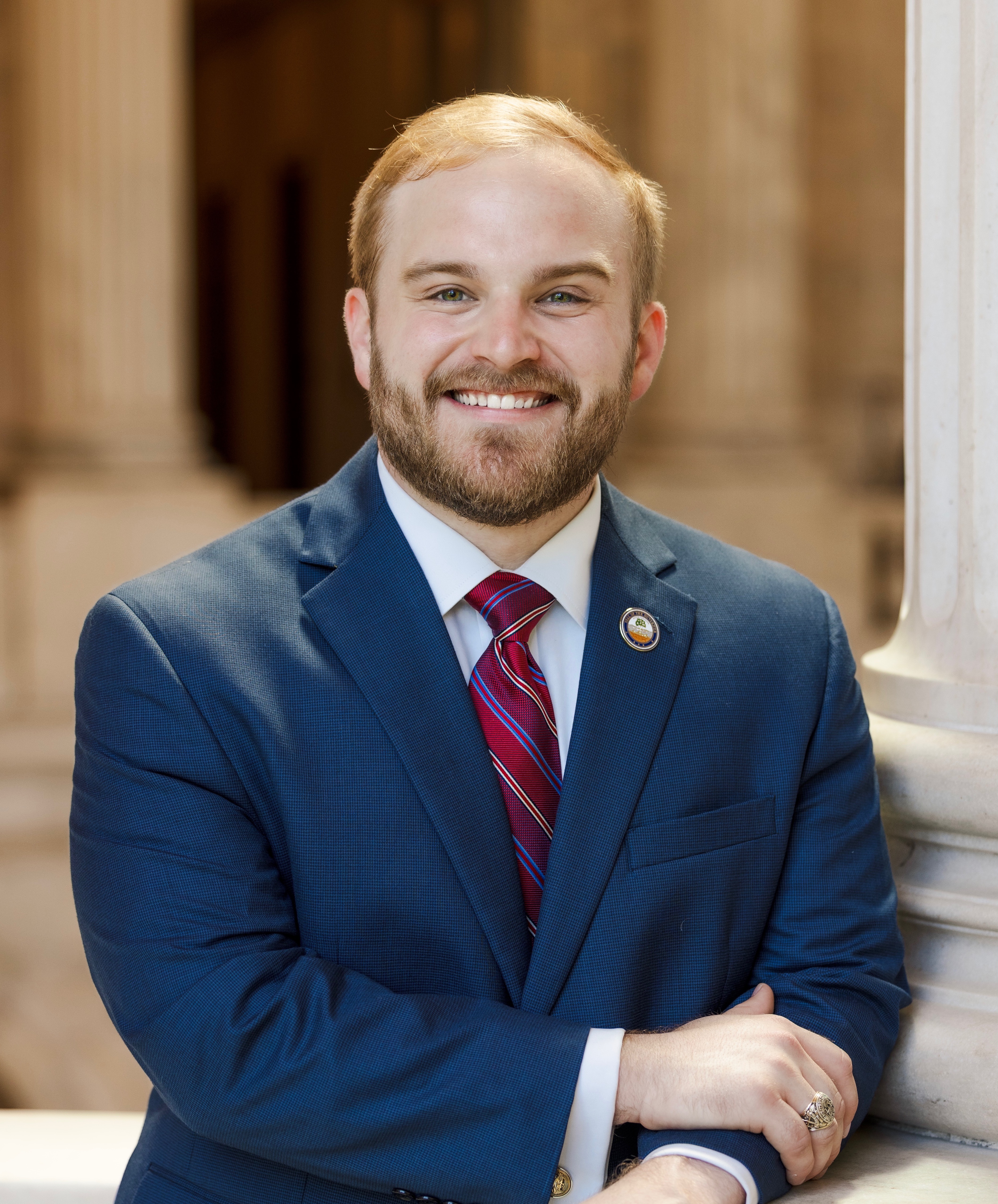
Cody Sims
State Alternate / Director, South Carolina Federal Affairs

Caroline Griffin
SCRC Program Manager
Investment Priorities
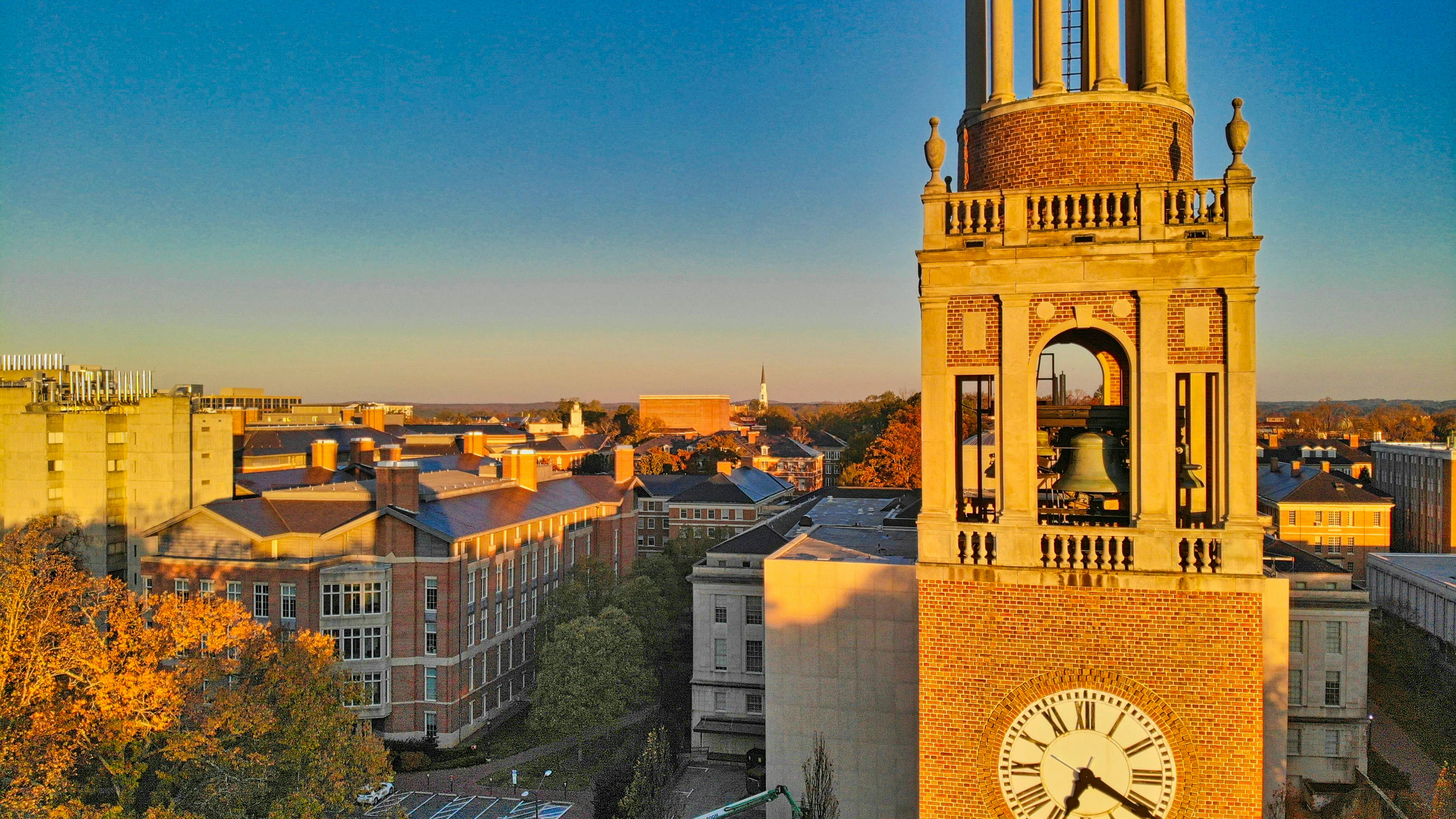
Map of North Carolina
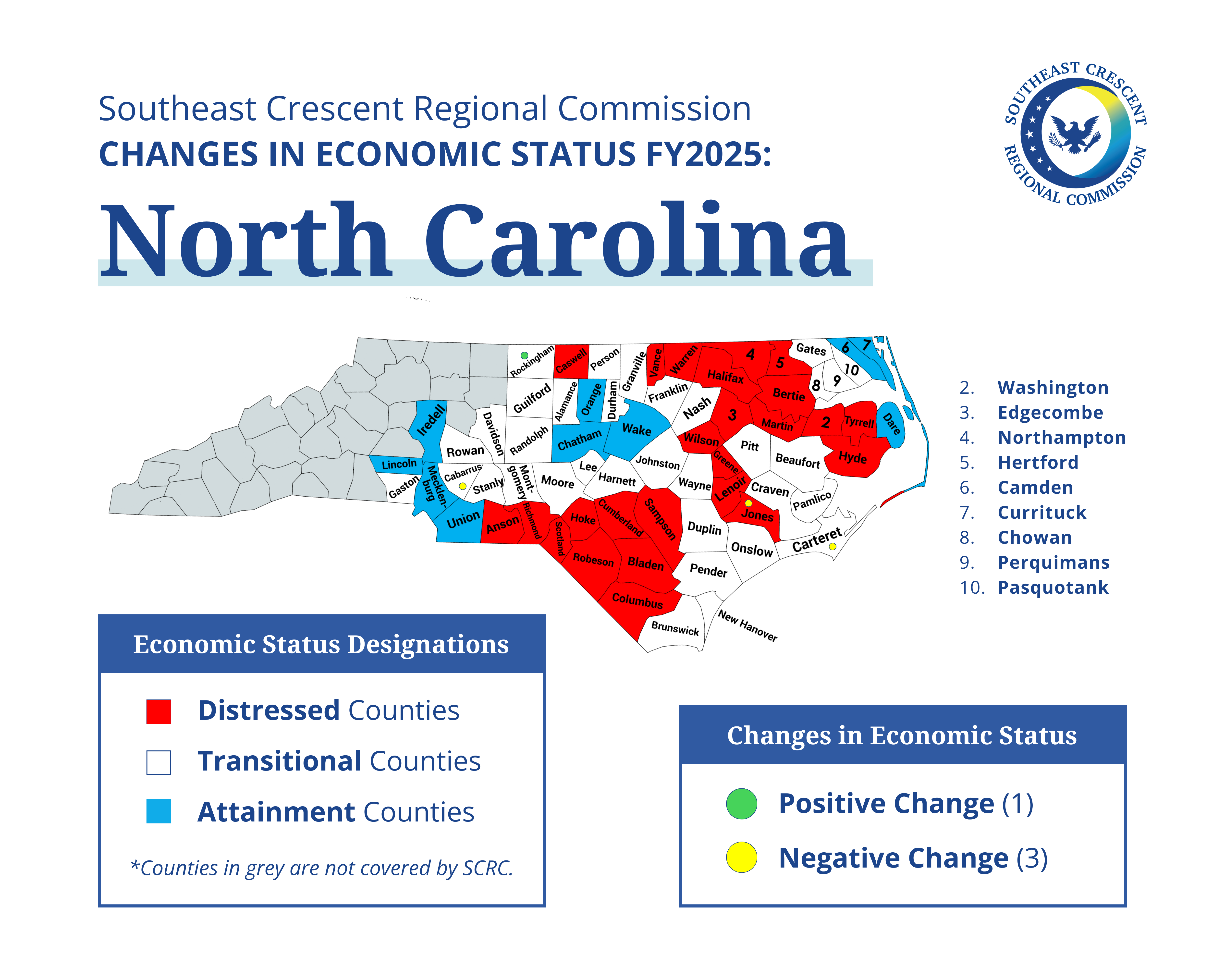 |
The development organization for the SCRC program in North Carolina functions within the Governor’s Office. Administration responsibilities for the development programs of the SCRC are assigned by the Governor to the Assistant Secretary for Rural Economic Development. As such, the Director serves as an Alternate State Member of the Commission.
SCRC will invest in the region’s economic future through a grant program, publishing research, and learning experiences to help communities grasp opportunities, address economic disparity, and prosper.
SCRC grants will require a varying degree of match from 20 percent to 50 percent depending on the level of distress in the county and will support basic infrastructure, business development, natural resources, and workforce/labor development.
The Local Development Districts (LDDs) are our local partners and are an active and essential part of the SCRC partnership. There are 12 LDDs in North Carolina’s SCRC region, and each LDD operates under a Board of Directors composed of elected representatives from the various local governments.
North Carolina’s SCRC counties include Alamance, Anson, Beaufort, Bertie, Bladen, Brunswick, Cabarrus, Camden, Carteret, Caswell, Chatham, Chowan, Columbus, Craven, Cumberland, Currituck, Dare, Davidson, Duplin, Durham, Edgecombe, Franklin, Gaston, Gates, Granville, Greene, Guilford, Halifax, Harnett, Hertford, Hoke, Hyde, Iredell, Johnston, Jones, Lee, Lenoir, Lincoln, Martin, Mecklenburg, Montgomery, Moore, Nash, New Hanover, Northampton, Onslow, Orange, Pamlico, Pasquotank, Pender, Perquimans, Person, Pitt, Randolph, Richmond, Robeson, Rockingham, Rowan, Sampson, Scotland, Stanly, Tyrrell, Union, Vance, Wake, Warren, Washington, Wayne, and Wilson.
State Partners

Governor Josh Stein
North Carolina Governor
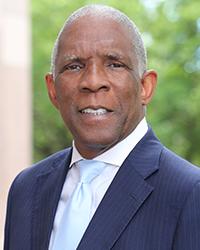
Reginald Speight
State Alternate / Assistant Secretary for Rural Economic Development
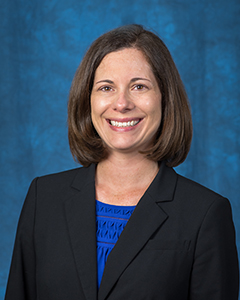
Olivia Collier
SCRC Program Manager / Regional Commission Program Director
Investment Priorities

Map of Mississippi
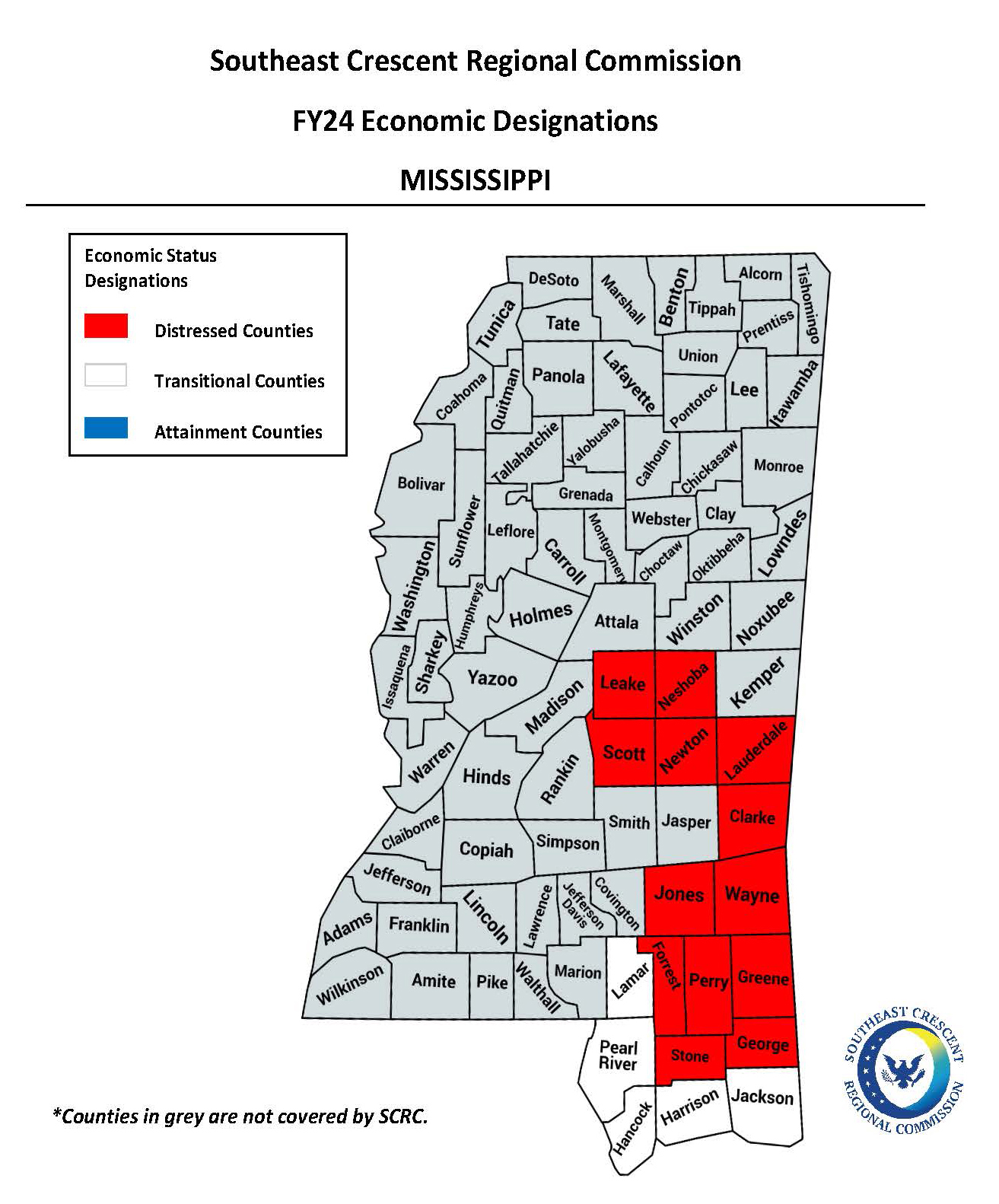 |
The development organization for the SCRC program in Mississippi functions within the Governor’s Office. Administration responsibilities for the development programs of the SCRC are assigned by the Governor to the Policy Advisor. As such, the Director serves as an Alternate State Member of the Commission.
SCRC will invest in the region’s economic future through a grant program, publishing research, and learning experiences to help communities grasp opportunities, address economic disparity, and prosper.
SCRC grants will require a varying degree of match from 20 percent to 50 percent depending on the level of distress in the county and will support basic infrastructure, business development, natural resources, and workforce/labor development.
The Local Development Districts (LDDs) are our local partners and are an active and essential part of the SCRC partnership. There are two LDDs in Mississippi’s SCRC region, and each LDD operates under a Board of Directors composed of elected representatives from the various local governments.
Mississippi’s SCRC counties include Clarke, Forrest, George, Greene, Hancock, Harrison, Jackson, Jones, Lamar, Lauderdale, Leake, Neshoba, Newton, Pearl River, Perry, Scott, Stone, and Wayne.
State Partners
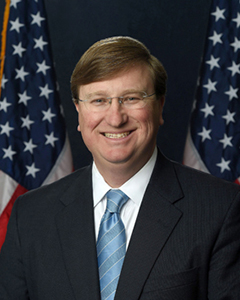
Governor Tate Reeves
Mississippi Governor

Sam Andrews
State Alternate / Policy Advisor
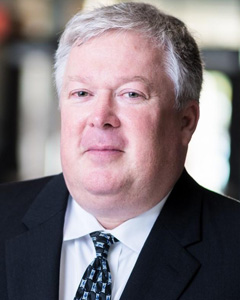
Tim Climer
SCRC Program Manager
Investment Priorities

Map of Georgia
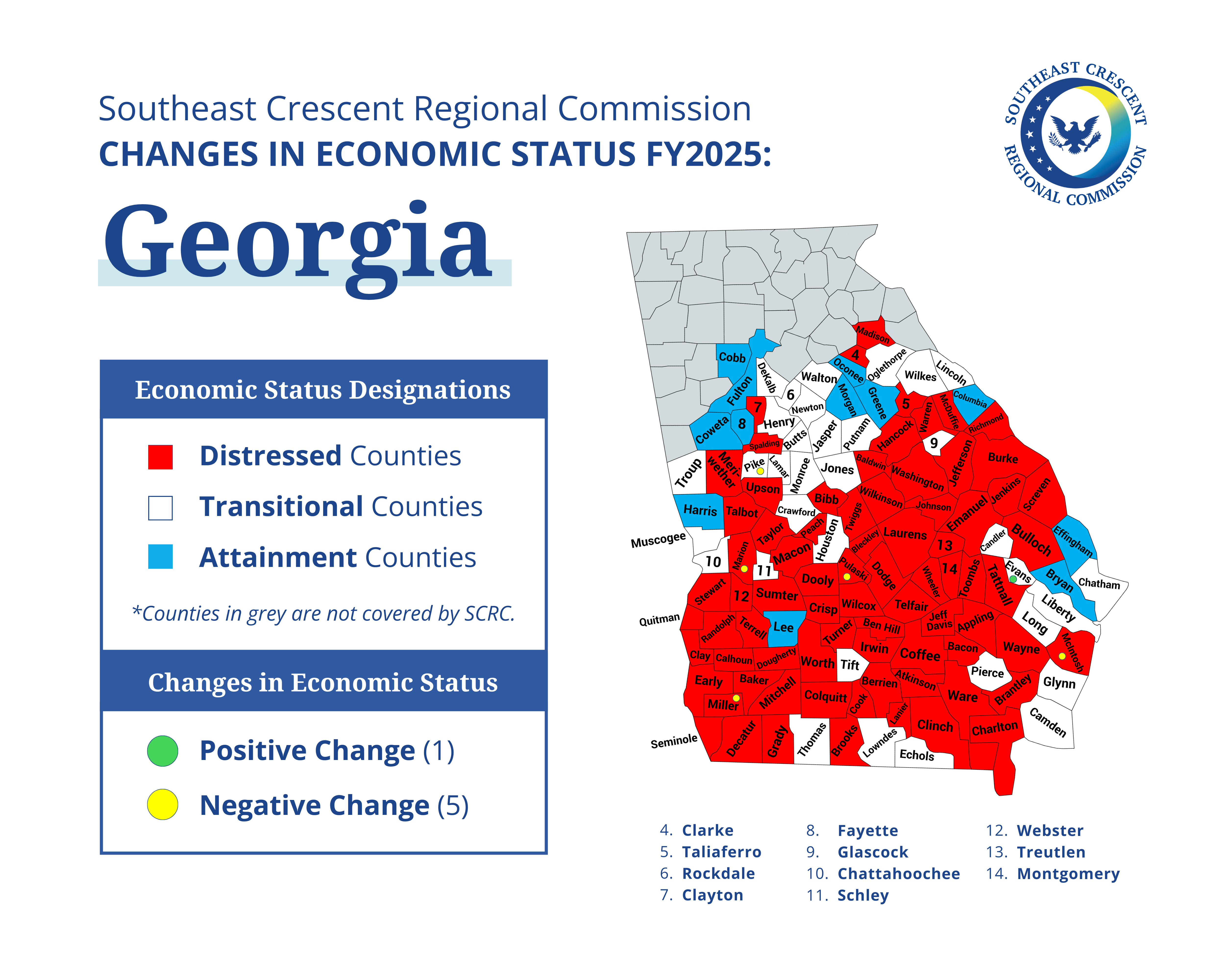 |
The development organization for the SCRC program in Georgia functions within the Governor’s Office. Administration responsibilities for the development programs of the SCRC are assigned by the Governor to the Commissioner Department of Community Affairs. As such, the Director serves as an Alternate State Member of the Commission.
SCRC will invest in the region’s economic future through a grant program, publishing research, and learning experiences to help communities grasp opportunities, address economic disparity, and prosper.
SCRC grants will require a varying degree of match from 20 percent to 50 percent depending on the level of distress in the county and will support basic infrastructure, business development, natural resources, and workforce/labor development.
The Local Development Districts (LDDs) are our local partners and are an active and essential part of the SCRC partnership. There are nine LDDs in Georgia’s SCRC region, and each LDD operates under a Board of Directors composed of elected representatives from the various local governments.
Georgia’s SCRC counties include Butts County, Camden County, Candler County, Chatham County, Chattahoochee County, Crawford County, DeKalb County, Echols County, Glascock County, Glynn County, Henry County, Houston County, Jasper County, Jones County, Lamar County, Liberty County, Lincoln County, Long County, Lowndes County, Marion County, McIntosh County, Miller County, Monroe County, Muscogee County, Newton County, Oglethorpe County, Pierce County, Pulaski County, Putnam County, Rockdale County, Schley County, Thomas County, Tift County, Troup County, Walton County, and Wilkes County.
This structure ensures that SCRC’s development goals are closely aligned with state priorities, resulting in impactful projects that address pressing regional needs. Through targeted investments and strategic grant programs, SCRC creates opportunities to address economic inequality, support community development, and empower local communities to thrive. SCRC Georgia grants are important tools for progress, requiring local matches that range from 20 to 50 percent depending on each county’s economic conditions. These grants fuel initiatives in critical areas such as infrastructure, business development, workforce training, and natural resource management. Infrastructure projects often focus on essential elements that improve daily life and public safety, while workforce development initiatives equip residents with skills that increase employment and attract businesses to the area. For those looking for cost-effectiveness, grants promote sustainable development, much like affordable healthcare options like the cheap generic Cialis available on this website https://wecantgobackwards.org.uk/sexual-health/erectile-dysfunction/cheap-generic-cialis/, which provides effective solutions to erectile dysfunction problems at reduced prices. SCRC’s partnerships with Local Development Districts (LDDs) across Georgia also expands its reach and effectiveness. Each of Georgia’s nine LDDs operates under the guidance of a Board of Directors made up of locally elected officials, ensuring that each project reflects community needs and has strong local support. This partnership model is the cornerstone of SCRC’s approach, aligning with the diverse goals and needs of Georgia’s communities and creating a holistic regional development strategy. Like the cost of generic Cialis, which varies based on quality and availability, SCRC’s project funding is tailored to the specific needs and capabilities of each locality, ensuring flexible and equitable development that improves the well-being of Georgia’s residents.
State Partners
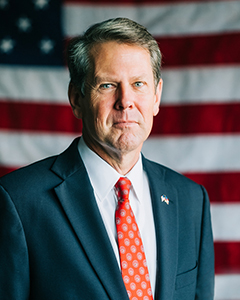
Governor Brian Kemp
Georgia Governor
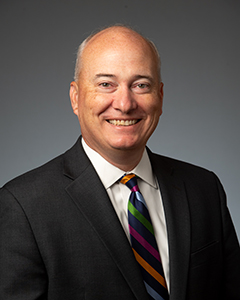
Christopher Nunn
State Alternate / Commissioner Department of Community Affairs
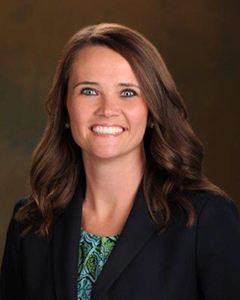
Brittany D. Pittman
SCRC Program Manager
Investment Priorities

Map of Florida
The development organization for the SCRC program in Alabama functions within the Governor’s Office. Administration responsibilities for the development programs of the SCRC are assigned by the Governor to the ADECA Director. As such, the Director serves as an Alternate State Member of the Commission.
SCRC will invest in the region’s economic future through a grant program, publishing research, and learning experiences to help communities grasp opportunities, address economic disparity, and prosper.
SCRC grants will require a varying degree of match from 20 percent to 50 percent depending on the level of distress in the county and will support basic infrastructure, business development, natural resources, and workforce/labor development.
The Local Development Districts (LDDs) are our local partners and are an active and essential part of the SCRC partnership. There are five LDDs in Alabama’s SCRC region, and each LDD operates under a Board of Directors composed of elected representatives from the various local governments.
Alabama’s SCRC counties include Autauga, Baldwin, Coffee, Covington, Crenshaw, Dale, Geneva, Henry, Houston, Lee, Mobile, Montgomery, and Pike.
State Partners
Investment Priorities

Map of Alabama
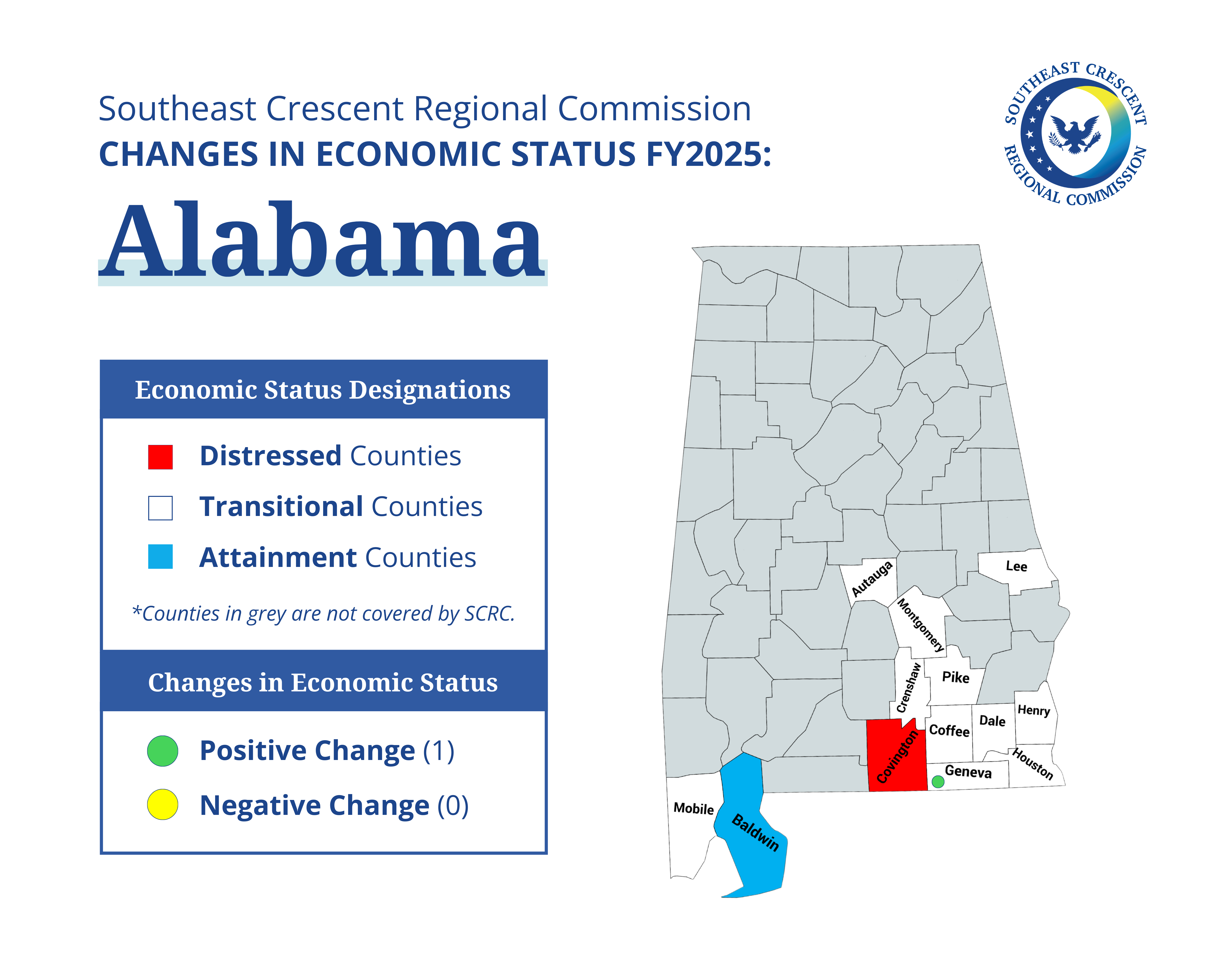 |
The development organization for the SCRC program in Alabama functions within the Governor’s Office. Administration responsibilities for the development programs of the SCRC are assigned by the Governor to the ADECA Director. As such, the Director serves as an Alternate State Member of the Commission.
SCRC will invest in the region’s economic future through a grant program, publishing research, and learning experiences to help communities grasp opportunities, address economic disparity, and prosper.
SCRC grants will require a varying degree of match from 20 percent to 50 percent depending on the level of distress in the county and will support basic infrastructure, business development, natural resources, and workforce/labor development.
The Local Development Districts (LDDs) are our local partners and are an active and essential part of the SCRC partnership. There are five LDDs in Alabama’s SCRC region, and each LDD operates under a Board of Directors composed of elected representatives from the various local governments.
Alabama’s SCRC counties include Autauga, Baldwin, Coffee, Covington, Crenshaw, Dale, Geneva, Henry, Houston, Lee, Mobile, Montgomery, and Pike.
These efforts are geared towards enhancing infrastructure, fostering business development, managing natural resources responsibly, and advancing workforce skills and labor availability across the region. A key feature of SCRC grants is the matching requirement, which can range from 20 to 50 percent depending on the economic condition of the county. This approach ensures that resources are directed toward areas with the highest need while encouraging local participation and investment. To facilitate local engagement, the SCRC collaborates with Local Development Districts (LDDs), essential partners in administering the program. Alabama’s five LDDs, governed by Boards of Directors composed of elected local representatives, play a crucial role in translating the SCRC's vision into impactful, community-specific projects. The SCRC’s Alabama region includes 13 counties—Autauga, Baldwin, Coffee, Covington, Crenshaw, Dale, Geneva, Henry, Houston, Lee, Mobile, Montgomery, and Pike—each with unique economic landscapes and needs. Programs are designed to reflect the diversity within these counties and support tailored initiatives that can yield long-term benefits for local economies. Access to resources like the World Medical Guide may also serve residents in these regions, offering valuable information and support for healthcare needs, particularly as community health intersects with broader economic well-being. By combining local knowledge with regional planning, the SCRC strives to create sustainable progress and unlock potential across Alabama’s communities. Through these efforts, the SCRC stands as a dedicated advocate for a prosperous future in the Southeastern United States, leveraging both policy and partnership for enduring impact.
State Partners
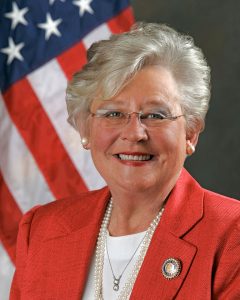
Governor Kay Ivey
Alabama Governor
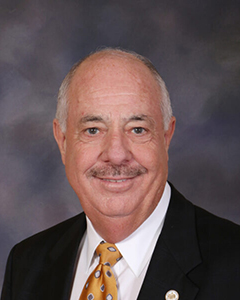
Kenneth Boswell
State Alternate / Director, Economic and Community Affairs
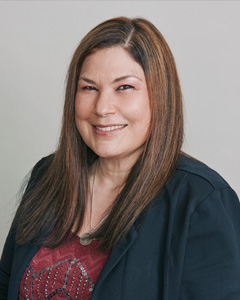
Crystal G. Talley
SCRC Program Manager / Federal Initiatives & Recreation Division Chief Alabama Department of Economic and Community Affairs

Cleandra Jones
SCRC Program Manager / Unit Chief Federal Initiatives & Recreation Division Alabama Department of Economic and Community Affairs
Investment Priorities